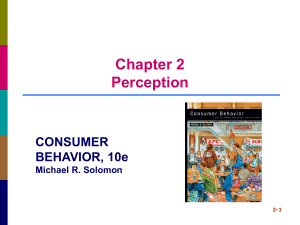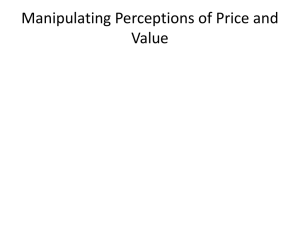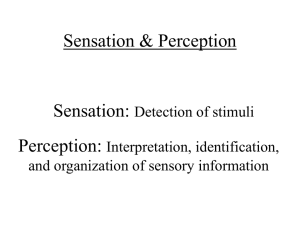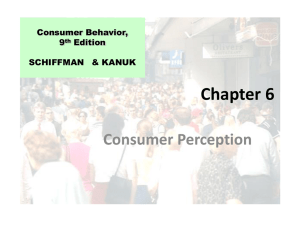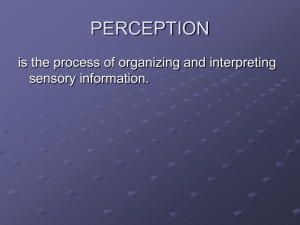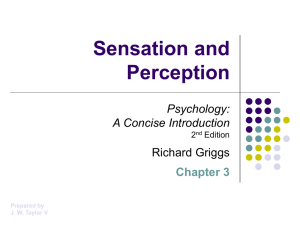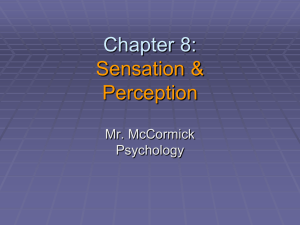Consumer Behavior Perception 1) The immediate response by our
advertisement
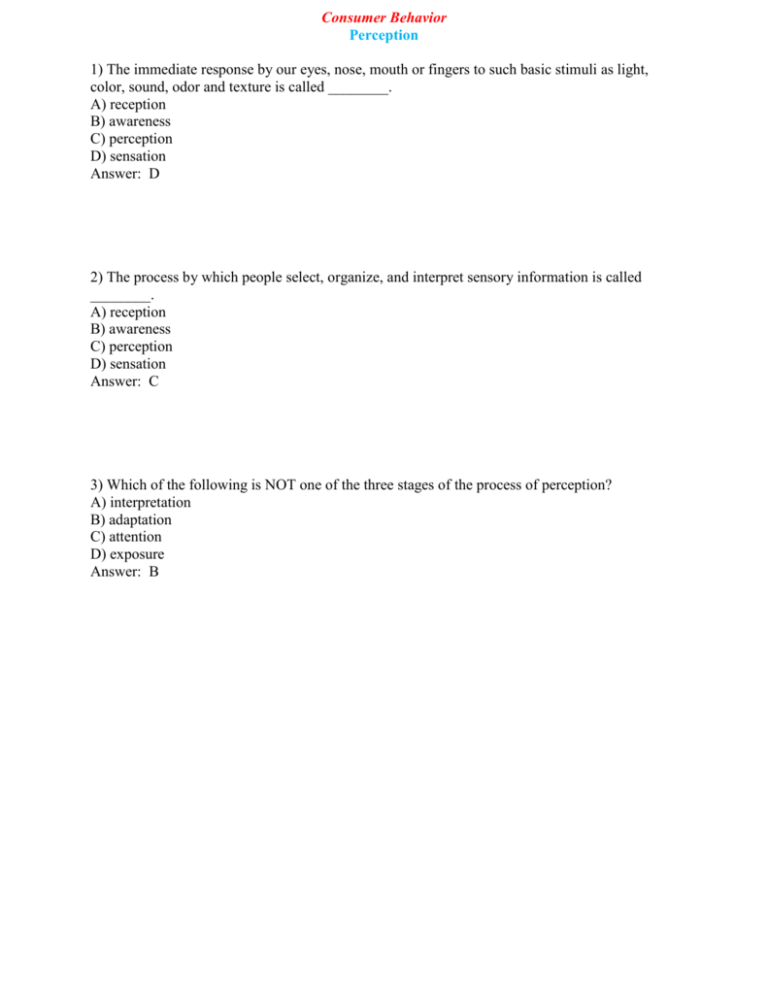
Consumer Behavior Perception 1) The immediate response by our eyes, nose, mouth or fingers to such basic stimuli as light, color, sound, odor and texture is called ________. A) reception B) awareness C) perception D) sensation Answer: D 2) The process by which people select, organize, and interpret sensory information is called ________. A) reception B) awareness C) perception D) sensation Answer: C 3) Which of the following is NOT one of the three stages of the process of perception? A) interpretation B) adaptation C) attention D) exposure Answer: B 4) As manufacturing costs decrease and the amount of products that people accumulate goes up, consumers increasingly want to buy things that will provide ________ value. A) hedonic B) Gestalt C) embedded D) referent Answer: A 5) Research has indicated that the color ________ creates feelings of arousal and stimulates appetite. A) blue B) red C) yellow D) black Answer: B 6) The sensory characteristic of a product that sticks with consumers, helping them to remember the product in a unique way, is called the ________. A) phoneme B) schema C) sensory signature D) interpretant Answer: C 7) Some color combinations come to be so strongly associated with a corporation that they become known as the company's ________. A) position B) signature C) trade dress D) schema Answer: C 8) Which of the following refers to the process by which the way a word sounds influences the listener's assumptions about what the word describes? A) sound symbolism B) audio watermarking C) semiotics D) the principle of similarity Answer: A 9) When Jane shops, she must feel the fabric of any potential clothing buy before she even bothers to see what the design is. She has a high need to touch. Which sense system is important to Jane in her clothing shopping? A) visual B) auditory C) haptic D) liminal Answer: C 10) A philosophy that translates customers' feelings into design elements is called ________ engineering. A) Kinsei B) Sigma C) relationship D) reverse Answer: A 11) When a stimulus comes within the range of someone's sensory receptors, ________ occurs. A) just noticeable difference (j.n.d.) B) retention C) subliminal suggestion D) exposure Answer: D 12) The ________ threshold refers to the minimum amount of stimulation that can be detected on a sensory channel. A) absolute B) differential C) intensity D) relative Answer: A 13) The minimum difference that can be detected between two stimuli is known as the ________. A) "bare" minimum B) gradual differentiation C) j.n.d. (just noticeable difference) D) graded difference Answer: C 14) The ________ threshold refers to the ability of a sensory system to detect changes between two stimuli. A) absolute B) differential C) intensity D) relative Answer: B 15) According to Weber's Law, the ________ the initial stimulus, the greater a change must be for people to notice the change. A) more common B) stronger C) weaker D) more unusual Answer: B 16) ________ occurs when a stimulus is below the level of an individual's awareness. A) Absolute threshold B) Differential threshold C) Subliminal perception D) Perceptual selection Answer: C 17) ________ refers to the extent to which processing activity is devoted to a particular stimulus. A) Exposure B) Perception C) Attention D) Sensation Answer: C 18) The average adult is exposed to about 3,500 pieces of advertising information every single day, far more information than they can or are willing to process. Consumers who are exposed to more information than they can process are in a state of ________. A) advertising bombardment B) sensory overload C) sensory shifting D) circuit overcapacity Answer: B 19) Processing information from more than one medium at a time is known as ________. A) multitasking B) perceptual hyperactivity C) perceptual chunking D) interactive attention Answer: A 20) Because the brain's capacity to process information is limited, consumers are very selective about what they pay attention to and tend to select stimuli that relate to their current needs. This type of perceptual filter is called ________. A) perceptual defense B) perceptual vigilance C) subliminal perception D) adaptation Answer: B 21) An individual may not process stimuli that are in some way threatening, or may distort the meaning of a stimulus to make it less threatening. This type of perceptual filter is called ________. A) perceptual defense B) perceptual vigilance C) subliminal perception D) adaptation Answer: A 22) According to the exposure factor leading to adaptation, frequently encountered stimuli ________ as the rate of exposure increases. A) adapt B) habituate C) prime D) overload Answer: B 23) According to the ________ factor leading to adaptation, simple stimuli habituate because they do not require attention to detail. A) exposure B) vigilance C) discrimination D) relevance Answer: C 24) Size, color, position, and novelty are all strategies for creating which of the following? A) contrast B) adaptation C) vigilance D) thresholds Answer: A 25) Which of the following refers to the meanings we assign to sensory stimuli? A) schema B) semiotics C) interpretation D) perception Answer: C 26) In the process of ________, certain properties of a stimulus evoke a schema. A) priming B) differentiating C) indexing D) perceptual mapping Answer: A 27) When we ________ products, we evaluate them using schemas we typically apply to classify people. A) prime B) filter C) imprint D) anthropomorphize Answer: D 28) Our brains tend to relate incoming sensations to others already in memory, based on some fundamental organizational principles. These principles derive from ________, a school of thought that maintains that people interpret meaning from the totality of a set of stimuli rather than from any individual stimulus. A) Freudian psychology B) Gestalt psychology C) Simmons psychology D) the Covey approach Answer: B 29) ________ roughly means whole, pattern, or configuration; this perspective is best summarized by the saying "The whole is greater than the sum of its parts." A) Freudian traits analysis B) Weber's Law C) Gestalt D) Kinsei Answer: C 30) A new Green Giant ad campaign relied on the ________ when it used a redesigned package for Green Giant products that showed the Green Giant in a "sea of green." It was felt that the Green Giant products were now unified under a common design banner. A) principle of similarity B) figure-ground principle C) subliminal principle D) closure principle Answer: A 31) The field of ________ examines the correspondence between signs and symbols and their role in the assignment of meaning. A) semiotics B) psychophysics C) Gestalt D) hyperreality Answer: A 32) From a semiotic perspective, every marketing message has three basic components. Which of those components is the sensory image that represents the intended meaning? A) the sign B) the object C) the interpretant D) the structure Answer: A 33) A(n) ________ is a sign that relates to a product by either conventional or agreed-on associations. A) icon B) index C) symbol D) schema Answer: C 34) A common practice among advertisers is to create new relationships between objects and interpretants by inventing new connections between products and benefits. A classic example of this was equating Marlboro cigarettes with the American frontier spirit. Which of the following terms best describes this practice? A) subliminal persuasion B) figure-ground projection C) semiotic relationships D) consumer-modeling connections Answer: C 35) The ________ for a brand guides how a company uses elements of the marketing mix to influence the consumer's interpretation of the brand's meaning in the marketplace relative to its competitors. A) positioning strategy B) Gestalt psychology C) sensory signature D) priming strategy Answer: A 36) Lifestyle, attributes, competitors, and quality are all dimensions marketers can use to carve out a brand's ________ in the marketplace. A) sensory signature B) position C) priming D) trade dress Answer: B 37) Ben Perez is driving along a mountain road. In the distance, he sees a road crew working on a fallen tree that has blocked the highway. When Ben first sees the road crew, which of the following perceptual processes has been engaged? A) exposure B) attention C) adaptation D) interpretation Answer: A 38) Nadia Ali loves the feel of her new sweater and the smell of her leather car seats on a crisp fall day. As she passes a billboard, she sees an ad for Baskin-Robbins ice cream and immediately does a U-turn into the shopping center where she knows the famous ice cream store is located. In the above example, Nadia is responding to ________. A) sensory inputs emanating from the external environment B) sensory inputs emanating from the internal environment C) emotional outputs D) decision sequences dictated by sensory outputs Answer: A 39) When a gas station blows "fresh coffee smell" around the gas pumps to tempt customers to come inside for a cup, the gas station is using a form of ________ marketing to influence customers. A) one-on-one B) subliminal C) differentiated D) sensory Answer: D 40) A billboard is positioned beside a busy highway. However, the merchant that has purchased the billboard complains that no response is being generated by his advertising message. Upon closer inspection, the billboard company determines that the typeface used is too small to be effectively read by a motorist going 60+ mph on the highway. Which of the following sensory thresholds would be most appropriate to explain the failure of this advertisement to connect with motorists? A) the intensity threshold B) the differential threshold C) the absolute threshold D) the relative threshold Answer: C 41) Jason and Mark were talking in class, but so was everyone else. As they continued to discuss their day's adventures, it suddenly became clear to them that the teacher was staring at them. They didn't realize that the class had been called to order and what was once only one conversation among many was now disruptive. Jason apologized quickly and the teacher resumed her normal activities. This is a good example of how a consumer's ability to detect a difference between two stimuli is ________. A) absolute B) negligible C) relative D) embedded Answer: C 42) A retailer decides to reduce the price of a sport coat that normally costs $98. The reduction in price is $3. The storeowner believes that the reduction will catch the eye of the value shopper. If the sport coat does not sell, the retailer might wish to consider which of the following before making another price change? A) subliminal perception B) the figure-ground principle C) the golden triangle D) Weber's law Answer: D 43) Mary Nabholz travels the same way to work every day. She notices advertisements in store windows when the ads first go up. However, after a few days, Mary no longer pays any attention to these ads because they have become familiar. Which of the following personal selection factors is affecting Mary Nabholz's response to the ads? A) perceptual vigilance B) perceptual defense C) contrast D) adaptation Answer: D 44) In the past ketchup formed an unbecoming "scum" on its surface if it was exposed to the air, so manufacturers created the traditionally shaped ketchup bottle with the narrow opening. When chemicals were developed to reduce this oxidation, it was then possible to sell ketchup in more conveniently shaped containers. Customers, however, rejected bottles that didn't have the traditional ketchup shape. This is an example of the power of ________ in the marketplace. A) sensory overload B) thresholds C) hyperreality D) schema Answer: D 45) Which of the following comes closest in characterizing the concept of hedonic consumption? A) Bill can't get an advertising jingle out of his mind when he enters a store and sees the product the jingle advertises. B) Kim can never buy fashionable clothes without looking carefully at their construction and then feeling the quality of the cloth with her fingers. C) Marcus often buys products just to make his wife angry. He thinks that since she is such a penny-pincher she ought to be punished. Buying unneeded items is how Marcus punishes her frugality. D) A new computer game rapidly replaced an older one because it had much faster action. Answer: B 46) One of the principles of psychophysics is that changes in the physical environment are not always matched by equal changes perceptually. If Madison Wilson were creating a new drink, what would psychophysics tell her? A) She could make the drink twice as sweet by adding twice the amount of sugar. B) She would need to research how the perception of "sweetness" changed by the amount of sugar added. C) She would need to look at the subliminal aspects of "sweetness." D) She would need to create promotions to tell customers how "sweet" the new drink is. Answer: B 47) Which of the following is most relevant to a company that wants to position a new brand on price leadership? A) Gestalt psychology B) Weber's Law C) augmented reality D) the closure principle Answer: B 48) Which of the following most accurately reflects the current thinking about the use of subliminal perception in marketing promotion and advertising? A) Subliminal messages are below the threshold of perception, so they cannot be utilized in marketing. B) Subliminal ads can be effective, but customers do not like them; therefore, marketers avoid them. C) There is some evidence that subliminal perception can have limited effects, but the effects are not specific enough to make subliminal messages effective in advertising. D) It comes down to a matter of attention. If a viewer will pay enough attention to a subliminal message, then it can have specific effects. Answer: C 49) All consumers carry schemata in their minds when they enter the marketplace. According to the principles of perceptual vigilance and defense, a marketer should be careful to create a promotion for the new product that ________. A) conforms to the customers' schemata B) violates the customers' schemata C) requires that customers defend their current views about the product category D) is simple and easy to understand Answer: A 50) A common practice among advertisers is to create new relationships between objects and interpretants by inventing new connections between products and benefits. How would a marketer use hyperreality to find a new use for baking soda? A) by associating the soda with its ability to absorb odors B) by associating the soda with a fictional character called Simon Soda C) by emphasizing the low cost of the soda D) by informing the customers of the historic importance of baking soda in germ protection Answer: B 51) Perception refers to the immediate response of our sensory receptors to such basic stimuli as light, color, and sound. Answer: FALSE 52) Unlike computers, people do not passively process whatever information happens to be present. Answer: TRUE 53) The first step in the perception process is exposure to a stimulus. Without exposure, there would be no perception. Answer: TRUE 54) Interpretation is the last stage of the perceptual process. Answer: TRUE 55) A behavioral researcher studying how consumers use multi-sensory, fantasy, and emotional factors in selecting products is studying hedonic consumption. Answer: TRUE 56) As people's incomes rise, they are more likely to prefer additional experiences over additional possessions. Answer: TRUE Learning Outcome: Describe the influence of social class and economic class on consumer behavior. 57) Sensory marketing has proven to be largely ineffective as a marketing approach. Answer: FALSE 58) Colors look duller to older people, which is why they prefer white and other bright tones. Answer: TRUE AACSB: Multicultural and diversity understanding 59) Some color combinations can become so associated with a company that the corporation may be granted exclusive use of these colors. Answer: TRUE 60) Fragrance is processed by the limbic system, the most primitive part of the brain and the place where immediate emotions are experienced. Answer: TRUE 61) Marketers have generally failed in their efforts to introduce scented marketing practices and products to the American marketplace. Answer: FALSE 62) Kinsei engineering focuses on the visual sense. Answer: FALSE 63) A consumer's ability to detect a difference between two stimuli is relative to the strength of those stimuli. Answer: TRUE 64) The absolute threshold is dependent upon how strong a marketer makes a stimulus. Answer: FALSE 65) Weber's Law states that the intensity of the stimulus is greater if its duration is increased. Answer: FALSE 66) Consumers are more likely to be aware of stimuli that relate to their current needs. This is an example of perceptual vigilance. Answer: TRUE 67) Novelty in the form of interruption intensifies our experiences, increasing our enjoyment of pleasant stimuli and amplifying our dislike of unpleasant stimuli. Answer: TRUE 68) The location of a product's image on a package influences the way our brains make sense of it; we perceive objects lower in a frame to be heavier than objects higher in the frame and objects on the right side of a frame heavier than those on the left side of the frame. Answer: TRUE 69) According to the retailer's rule of thumb based on the closure principle, when a sale catalog is created, the prices (on average) of the products in the catalog should be reduced by about 20 percent. Answer: FALSE 70) Alba is dedicated to fitness and nutrition. She rarely eats fast food because of the high calories and low nutritional value. Though Alba is exposed to many advertising messages from fast food restaurants each day, she rarely processes these messages. This is an example of subliminal perception. Answer: TRUE 71) You can understand the following uniquely-printed sentence because of the Gestalt principle of closure. Percption is imptant in undrstdng consmr bhavr. Answer: TRUE 72) On Lost, the popular television drama with mysterious and supernatural plotlines, the fictional Hanso foundation sponsors questionable research projects. Many Lost Web sites now sell items bearing the Hanso name and logo. This is an example of hyperreality. Answer: TRUE 73) The icons on the restroom doors in a bar in Wyoming were a doe and a buck. This is an excellent example of hyperreality. Answer: FALSE 74) Individuals have different absolute thresholds for visual and aural stimuli. This fact supports the statement that subliminal advertising would need to be tailored to the individual in order to be effective. Answer: TRUE 75) Sarah Palmer realizes she just made a mistake. In her hurried shopping trip, she picked up the yellow plastic squeeze bottle from the grocery store shelf, assuming that it was French's mustard. To her dismay, it was the store brand. Her confusion is an illustration of the importance of package schematics. Answer: TRUE 76) What is the difference between sensation and perception? Answer: Sensation is the immediate response of sensory receptors (such as the eyes, ears, nose, mouth, and fingers) to such basic stimuli as light, color, odor, texture, and sound. Anything that activates a receptor is called a stimulus. Perception is the process by which people select, organize, and interpret these sensations. The eventual interpretation of a stimulus allows it to be assigned meaning. 77) List the three stages of the perception process and give a brief definition of each. Answer: The three stages are exposure, attention, and interpretation. ∙ Exposure—the degree to which people notice a stimulus that is within range of their sensory receptors ∙ Attention—the extent to which processing activity is devoted to a particular stimulus ∙ Interpretation—the meaning that we assign to sensory stimuli 78) Define the concepts of hedonic consumption and sensory marketing, and then explain how they are related. Answer: Hedonic consumption refers to the multisensory, fantasy, and emotional aspects of consumers' interactions with products. Using sensory marketing, companies pay more attention to the impact of all five senses (vision, scent, sound, taste, and touch) on our product experiences. As incomes rise and consumer costs go down, consumers are more interested in the hedonic value of products. Therefore, marketers are more likely to use sensory marketing to increase the hedonic value of their market offerings. 79) Define perceptual selection and describe the types of filters that prevent clear perception and reception of marketing stimuli. Answer: Perceptual selection means people attend to only a small portion of stimuli to which they are exposed. Perceptual filters, based on our past experiences, influence what we decide to process. For example, perceptual vigilance occurs because consumers are more likely to be aware of stimuli that relate to their current needs. The flip side is perceptual defense. This means that people see what they want to see—and don't see what they don't want to see. Adaptation is the degree to which consumers continue to notice a stimulus over time. Factors that influence adaptation are intensity, duration, discrimination, exposure, and relevance. 80) As a personal selection factor, adaptation is seen as the degree to which consumers continue to notice a stimulus over time. Five factors can lead to adaptation. List and briefly describe the connection with adaptation. Answer: The five factors are intensity (less-intense stimuli habituate because they have less impact), duration (stimuli that are long in duration tend to habituate), discrimination (simple stimuli habituate because they do not require attention to detail), exposure (frequently encountered stimuli habituate as the rate of exposure increases), and relevance (stimuli that are irrelevant or unimportant habituate because they fail to attract attention). 81) Advertising has increasingly become less effective because of increased clutter. How can advertisers use contrast to cut through the clutter? Answer: Advertising attention can be enhanced by contrast using size, color, position, and novelty. High contrast can be achieved using any or all of the visual methods listed. 82) What does the word gestalt mean, and how does the term describe an important principle of the perceptual process? Answer: Gestalt means that the whole is greater than the sum of its parts. In the perceptual process, an analysis of each component of complex stimuli will not create the entire perception. Individual components are organized into a whole greater than any of its parts. 83) What does the study of semiotics attempt to do? Answer: Semiotics examines the correspondence between signs and symbols and their role in the assignment of meaning. 84) Outline and explain the parts of the perceptual process that would allow a shopper to recognize a ketchup bottle in a supermarket. Answer: The sensory stimuli is the bottle that is detected by the sensory receptors in the shopper's eyes. This exposure will result in a sensation. If the shopper pays attention to the sensation, her mind will organize and interpret these sensations through the process of perception. 85) As people age their sensory detection abilities decline. The Baby Boomers are fast reaching retirement age. How will advertisements in the future likely change sensory stimuli to accommodate this changing demographic? Answer: Colors look duller to older people, who prefer purer and brighter colors. It becomes increasingly difficult for older persons to separate background sounds from direct speech (figureground), requiring less distraction in the sound track. Because smell has the power to bring older memories to consciousness, it may become more important in advertisements in the future. 86) Research has shown Kinsei engineering can be an effective way to design products. Explain how Kinsei engineering works and give an illustration that demonstrates your understanding. Answer: Kinsei engineering is a Japanese philosophy that translates customers' feelings into design elements. For example, many carmakers have changed the design of the driver's seat to make drivers feel taller. Ford's version is called "Command Seating" to reinforce the feeling of power it wants drivers to experience as they look down on all those little vehicles buzzing around them. 87) Blind taste tests in the 1980s showed that most Coke drinkers preferred a cola that was sweeter than the current product. When Coca-Cola attempted to make its product sweeter, brand loyal customers revolted and demanded the old product be returned. Explain how Coca-Cola marketers could have used the principles of psychophysics to introduce the new coke without creating these problems. Answer: If the sweetness of the cola was increased by less than a j.n.d. in stages over time, the final product would be much sweeter without most brand loyal customers recognizing the change. 88) Evaluate the effectiveness of subliminal persuasion and messages in marketing. Be sure to demonstrate your knowledge of the evidence about the success of the technique as presented in the text. Answer: Under very specific conditions, some clinical psychologists suggest that people can be influenced by subliminal messages. However, the technique seems unlikely to be of use in marketing contexts; effective messages must be tailored to specific individuals rather than to mass markets. It has also been found that there are wide differences in individual threshold levels. In order for a message to avoid conscious detection by consumers who have a low threshold, the message would have to be so weak that it would not reach those with a high threshold. Next, advertisers lack control over where consumers are positioned in relationship to the source of the message; perhaps only a few would be within range of the stimulus. Lastly, consumers typically shift their attention when watching television or a movie. They might not even be looking at the screen when the message was flashed. Though there is virtually no proof that subliminal messages have any effect on consumer behavior, many consumers believe that subliminal persuasion is being used on them in some form. 89) A sign on a drawer in the kitchen of a fraternity said "Plastic Silver." The drawer contained plastic spoons, forks, and knives for casual dinners. Use the principle of hyperreality to explain why users of the kitchen would know what was in the drawer without looking. Answer: Dining implements in more upscale homes were often made of silver. More casual ware was generally made to look silver even when it didn't contain silver metal. Eventually, all dining implements became known as "silverware." This drawer, however, contained plastic objects, but the objects were used for dining. Fraternity members would know that the label "plastic silver" means the utensils in the drawer are plastic. 90) At a business meeting, a consultant states that "perception is reality, because a customer never works with the actual product, but only with his or her perception of that product." In a university lab, researchers determine that when a rat is looking at a brightly colored rectangle, a close inspection of the rat's optic nerves (that connect the eyes to the cortex) show no visible change from when the rat is looking at a green circle; however, electrodes placed in the nerve show a different pattern of transmitted codes. How are these two events related, and what does this relationship tell us about perception? Answer: The human mind never actually comes in contact with an outside stimulus such as a product. The mind only receives sensations created by the receptors, and then must interpret what those sensations are. This interpretation is a perception. The only thing the mind processes of the product is the perception created by that mind of that product, hence "perception is reality."
